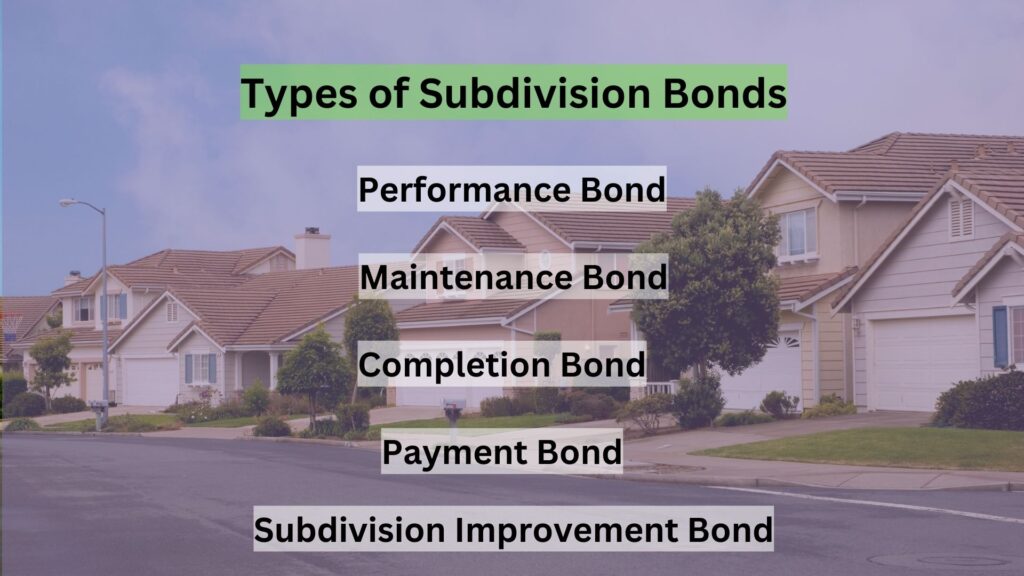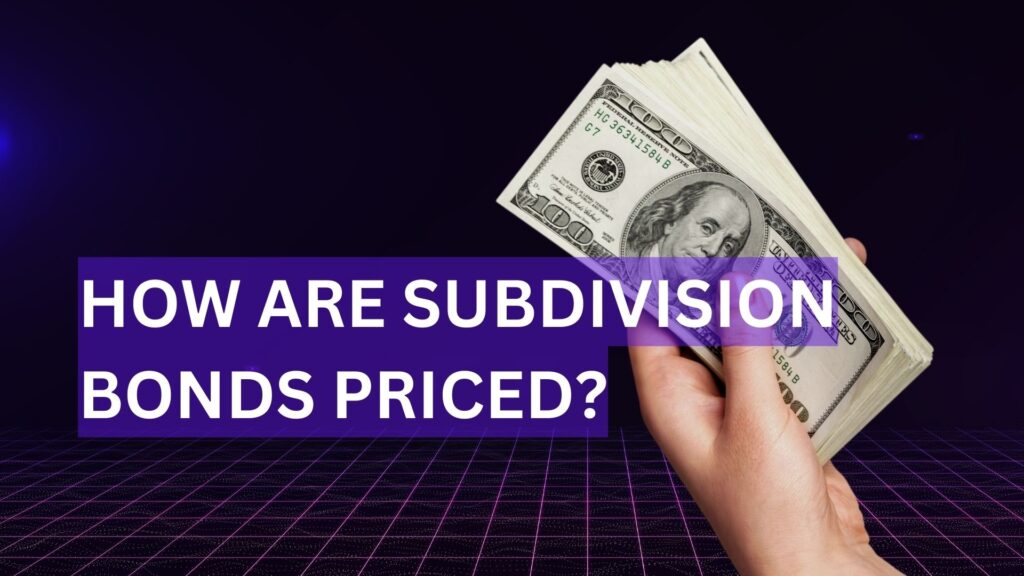What Is a Subdivision Bond?
What Is the Purpose of a Subdivision Bond?
Types of Subdivision Bonds
Subdivision bonds are a type of surety bond that developers or builders may be required to obtain when subdividing land for residential or commercial development. These bonds provide financial protection to the governing authorities and ensure that the developer completes all required infrastructure improvements, such as roads, sidewalks, utilities, drainage systems, and other public amenities. There are several types of subdivision bonds, including:
Performance Bond
This type of bond guarantees that the developer will complete the subdivision project according to the approved plans and specifications. It ensures that all infrastructure improvements will be constructed within the specified timeframe and meet the required standards.
Maintenance Bond
After the completion of the subdivision project, a maintenance bond may be required to ensure that the developer maintains and repairs the infrastructure improvements for a specific period, typically one to two years. This bond protects the governing authority and the future residents from any defects or deficiencies that may arise during the maintenance period.
Completion Bond
A completion bond, also known as a subdivision completion guarantee, is used when a developer fails to complete the required infrastructure improvements before selling individual lots. The bond guarantees that the remaining improvements will be completed as promised.
Payment Bond
In addition to the infrastructure improvements, developers are often required to pay contractors, subcontractors, and suppliers for their work and materials. A payment bond guarantees that these parties will be paid for their services, even if the developer fails to make the payments.
Subdivision Improvement Bond
This type of bond is specific to the financing of public infrastructure improvements. It guarantees that the developer will reimburse the governing authority for the costs of constructing or completing infrastructure improvements, such as roads, utilities, and drainage systems.
It’s important to note that the availability and specific requirements of subdivision bonds may vary depending on the jurisdiction and local regulations. Developers should consult with the relevant governing authority or a surety bond professional to determine the exact bond types and amounts needed for their subdivision project.
Benefits of Using Subdivision Bonds
Subdivision bonds, also known as completion or performance bonds for subdivision projects, offer several benefits to various parties involved. Here are some benefits of using subdivision bonds:
Ensures Completion of Infrastructure
Subdivision bonds guarantee that the developer will complete the necessary infrastructure, such as roads, drainage systems, utilities, and other public improvements, as outlined in the approved subdivision plans. This ensures that the subdivision is fully developed and functional, benefiting both the developer and future property owners.
Protects Homebuyers and Property Owners
Subdivision bonds provide protection to homebuyers and property owners within the subdivision. If the developer fails to complete the infrastructure or meet the necessary requirements, the bond can be used to cover the costs of completing the unfinished work. This helps prevent homeowners from being burdened with incomplete or inadequate infrastructure.
Financial Security
By requiring a subdivision bond, local authorities or municipalities can ensure that there is a financial guarantee in place to cover the costs of completing the infrastructure if the developer fails to do so. This provides financial security and minimizes the risk of public funds being used to complete the unfinished work.
Quality Assurance
Subdivision bonds encourage developers to complete the project to a certain standard and within the agreed-upon timeframe. The bond serves as an incentive for the developer to deliver high-quality infrastructure, as they are financially liable if they do not meet the specified requirements. This helps maintain the overall quality and integrity of the subdivision.
Risk Mitigation
Subdivision bonds help mitigate the risk for local authorities, municipalities, and property owners. If the developer fails to complete the infrastructure or defaults on their obligations, the bond can be used to cover the costs of completing the unfinished work. This reduces the financial risk and potential disruptions for all parties involved.
Compliance with Regulations
Subdivision bonds ensure compliance with local regulations and requirements. They provide assurance that the developer will adhere to all applicable laws and regulations in terms of infrastructure development, thereby promoting safety, functionality, and compliance within the subdivision.
How Are Subdivision Bonds Structured?
How Are Subdivision Bonds Priced?
Risks Associated With Subdivision Bonds
While subdivision bonds offer benefits, there are also risks associated with them. Here are some potential risks to consider:
Insufficient Coverage
In some cases, the bond amount may not be adequate to cover the full cost of completing the infrastructure if the developer defaults. If the actual costs exceed the bond amount, additional funds may need to be sourced from other parties, such as the local authority or property owners, to complete the unfinished work.
Bond Issuer Insolvency
The bond issuer, typically an insurance or surety company, may face financial difficulties or become insolvent. In such cases, there may be delays or challenges in accessing the bond proceeds to complete the infrastructure. It is important to select a reputable and financially stable bond issuer to mitigate this risk.
Delayed Completion
Despite the existence of a subdivision bond, there is a possibility that the developer may still face delays or challenges in completing the infrastructure as per the approved plans. This could result in inconvenience, additional costs, or disruptions for property owners and the community.
Dispute Resolution
If there are disagreements between the developer, local authorities, or property owners regarding the completion of the infrastructure or the use of bond proceeds, resolving these disputes can be time-consuming and costly. Proper documentation and clear contractual agreements are crucial to minimizing the risk of disputes and facilitating efficient resolution.
Inadequate Bond Terms
The terms and conditions of subdivision bonds can vary, and in some cases, they may not adequately protect the interests of local authorities or property owners. It is important to carefully review and negotiate the bond terms to ensure they align with the specific needs and requirements of the subdivision project.
Regulatory Changes
Changes in local regulations or laws governing subdivision bonds can pose risks. Alterations in bond requirements or coverage criteria may impact the effectiveness and adequacy of the bond, potentially affecting the completion of infrastructure or the financial protection provided to stakeholders.
What Are Subdivision Bond Requirements?
How Are Subdivision Bonds Typically Structured?
How Are Subdivision Bonds Typically Funded?
Who Is Responsible for Issuing Subdivision Bonds?
Conclusion
In conclusion, subdivision bonds offer benefits such as ensuring the completion of infrastructure, protecting homebuyers and property owners, providing financial security, promoting quality assurance, mitigating risks, and ensuring compliance with regulations. However, there are associated risks, including insufficient coverage, bond issuer insolvency, potential delays in completion, dispute resolution challenges, inadequate bond terms, and regulatory changes. To mitigate these risks, careful consideration should be given to bond amounts, selecting reputable bond issuers, reviewing and negotiating bond terms, and maintaining clear communication and documentation.
Consulting with legal and financial professionals familiar with local regulations is essential to navigate these risks effectively. Subdivision bonds play a vital role in facilitating the development of functional and safe subdivisions while safeguarding the interests of all parties involved.
See more at Fallbrookaz.com.


